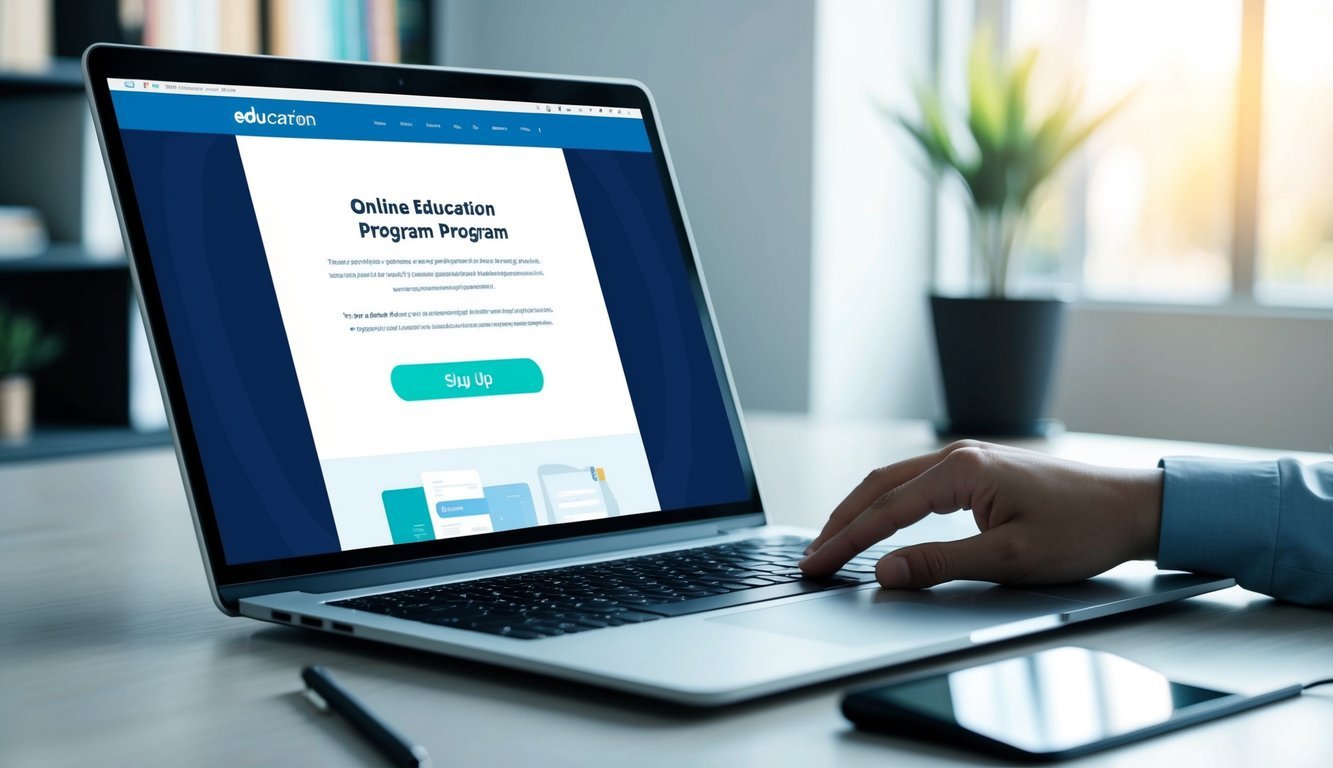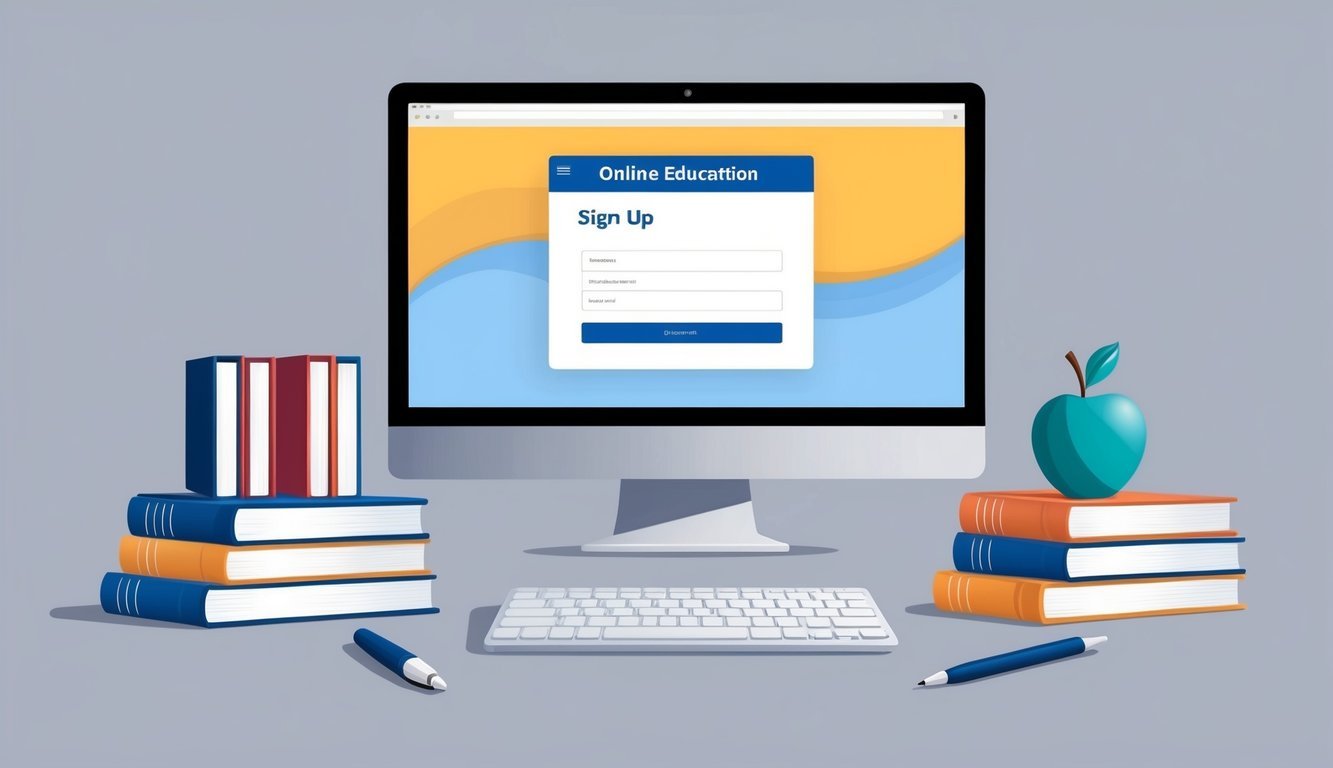Online education has truly taken off! It’s a fantastic way to learn all sorts of new skills or even snag a degree without ever stepping foot in a classroom.
Picture yourself studying comfortably on your couch, coffee in hand, or sneaking in a lesson during your lunch break at work.
Sounds appealing, right?

Getting Started with Online Education
Signing up for online courses? It’s a breeze! First things first, you’ll want to pick a program that aligns with your goals.
There are tons of online colleges out there offering a variety of degrees and courses.
Once you find a fit, the application process is pretty similar to that of a traditional school.
You fill out forms and may need to send over some documents.
Some schools might want to see test scores or essays, but once you’re accepted, you can dive right into classes!
Key Takeaways
- Online education gives students from all backgrounds a flexible way to learn.
- Researching the right program is crucial — think about your personal goals.
- The application process is simple and can usually be done online.
Choosing the Right Online Program
Finding the perfect online education program requires some thoughtful research.
Key factors to consider are the school’s reputation, accreditation, and the degree options available.
Comparing Online Colleges
As you compare online programs, look for things like tuition costs, graduation rates, and student support services.
Reviews from current students can be incredibly helpful, too! Don’t forget to think about the learning format: do you prefer live classes, or do you like the flexibility of pre-recorded lectures? Trust me, your preferred style can make all the difference.
It’s also wise to consider your tech setup.
Make sure your computer and internet speed are up to snuff for online classes.
Many schools offer tech support, which can make your life a lot easier!
Why Accreditation Matters
Let’s talk about accreditation — it’s a huge deal! Accreditation indicates that a school meets certain quality standards.
Generally, regional accreditation is considered the gold standard for colleges and universities.
If you’re thinking about a professional field, ensure that the program is recognized by the appropriate organizations.
For example, nursing programs often need the thumbs-up from nursing boards.
Investigate how schools maintain quality.
Do they refresh their courses regularly? Are their instructors trained to teach online? Getting answers to these questions can really enhance your learning experience.
Degrees vs. Certifications
Consider what you want to achieve with your education.
A bachelor’s degree might be ideal for many fields, but others may require specialized training.
Professional certificates can be a fast track to acquiring new skills — often shorter and super focused, making them great if you’re considering a career switch or aiming to level up in your current field.
And if you’re eyeing certain careers, advanced degrees like master’s or doctoral programs can lead to high-level positions and better pay, although they’re definitely more intense.
How to Sign Up and Start Learning
Ready to dive into online education? Signing up is a simple, straightforward process that can unlock a world of learning.
From creating an account to exploring courses, let’s get you started!
Creating Your Account
To kick off your online learning journey, you’ll need to create an account.
Platforms like Coursera make it easy and free! Here’s how:
- Head to the platform’s website.
- Click “Sign Up” or “Join.”
- Input your email address.
- Craft a strong password.
- Fill in some basic info like your name and where you’re from.
Some platforms even let you sign up using your Google or Facebook account, which can save you a few clicks and make logging in a breeze.
Enrolling in Your Program
Once you’re all set up, it’s time to dive into your courses! Here’s how to enroll:
- Browse course catalogs or use search tools.
- Read through program descriptions and syllabi.
- Check out the requirements and time commitments.
- Hit “Enroll” or “Join Course.”
- Follow the prompts to complete your registration.
And hey, remember to check your tech setup before you start.
A reliable internet connection and any specific software requirements are key!
Financial Aid Options
Don’t let finances hold you back.
Many online programs offer financial assistance:
- Look for “Financial Aid” options on course pages.
- Fill out applications honestly.
- Explain why you need assistance and how it could help you.
- See if your employer offers tuition benefits.
- Search for external scholarships related to your field.
Some platforms have scholarship programs of their own, while others can accept government financial aid for certain courses.
Don’t be afraid to check it out!
Discovering Professional Certificates
Professional certificates can be a great career booster.
Companies like IBM offer various programs through online platforms.
Here’s what you should know:
- Certificates hone in on specific job skills.
- They usually take less time than full degrees.
- Many are self-paced, allowing for flexibility.
- Some include hands-on projects or internships.
- Prices can vary, but they’re generally more affordable than traditional degrees.
Search for certificates that align with your career goals.
Reading reviews from former students can provide valuable insight into their market value.
Frequently Asked Questions

Online education opens up a world of possibilities, from K-12 programs to college courses.
Enrollment processes can vary widely.
Here are some answers to common questions about starting your online learning journey.
How do I enroll in an online high school?
To get started with online high school, students should first choose a program.
This involves filling out an application form and submitting necessary documents like transcripts and proof of age.
You may also need to take some placement tests, and typically, you’ll finalize things by paying tuition or fees.
What’s the enrollment deadline for K12 online programs this year?
K12 online schooling commonly has rolling admissions, so students can start throughout the year.
Some programs do have set start dates for each semester, so it’s smart to check with specific schools for their exact deadlines.
How can I find affordable online colleges with open enrollment?
To discover budget-friendly online colleges, use comparison websites, and be on the lookout for schools with open enrollment policies.
Don’t forget to check for financial aid options and compare the overall program costs, not just tuition!
Are there online colleges that allow immediate class starts?
Absolutely! Some online colleges offer quick start options.
These schools might have weekly or monthly start dates, allowing you to dive into your coursework shortly after enrolling.
Can I access free online schooling options in the US, and how?
Yes, free online schooling is available in the US, particularly for K-12 students.
Many public school districts have free virtual programs, and there are tuition-free online charter schools in various states.
For higher education, platforms like Coursera and edX offer free courses too!
What are the requirements for K12 online programs?
K12 online programs typically require proof of age and residence.
You may also need to submit previous school records or standardized test scores.
Plus, parents might need to demonstrate that they can provide necessary tech and supervision at home.

